So this is where my drinking water comes from?
The New River has supplied fresh drinking water to the capital for over 400 years; today it also provides a beautiful ‘green corridor’ that we followed right into the heart of the city.
WALK DATA
Distance: 13kms (8.1 miles) – you save 1km if you omit Abney Park Cemetery
Height Change: 27 metres
Typical time: 3 1/4 hours
Start: Alexandra Palace Station (N22 7ST)
Finish: Sadler’s Wells, Rosebery Avenue, (EC1R 4TN)
Terrain: Sturdy footwear recommended; cemetery can be muddy
‘Green Spaces’
| Parks, gardens, squares, cemeteries | Alexandra Park, Railway Fields Nature Reserve, Finsbury Park, Clissold Park, Abney Park, Aden Passage Gardens, Petherton Green, New River Walk, Astey’s Row, Duncan Terrace Gardens, Owen’s Field, Myddelton Square Gardens, Spa Green Garden |
| Rivers, canals, lakes | New River, Woodberry Wetlands, West Reservoir, Hackney Brook |
| Stunning cityscape | On the New River, just east of Green Lanes, looking north to Alexandra Palace |
‘Architectural Inspiration’
| Ancient Buildings & Structures (pre-1714) | St Mary’s Tower, New River Village (1500); St Mary’s Old Church (1563) |
| Georgian (1714-1836) | Clissold House (1793), Stoke Newington Church St |
| Victorian & Edwardian (1837-1918) | Abney Park (1840), Stoke Newington Public Library (1890), St Mary’s New Church (1858) |
| Industrial Heritage | Hornsey Pump House (1901), Castle Pumping Station (1854) |
| Modern (post-1918) | New River Village (2010), St Paul the Apostle Church (1993), Stoke Newington Town Hall (1937), New River Head Building (1919), Laboratory Building (1938), Spa Green Estate (1946) |
‘Fun stuff’
| Great ‘Pit Stops’ | Lizzy’s @The Coal House, Clissold Park Café |
| Quirky Shopping | Stoke Newington Church St; Camden Passage, Islington |
| Places to visit | Abney Park Cemetery |
| Popular annual festivals & events | Clissold Park: Food and Drink Festival (May), Yoruba Arts Festival (July) |
Some famous Stoke Newington inhabitants:
Eric Bristow (darts champion), Joseph Conrad (novelist), Daniel Defoe (writer), Paul Foot (political writer), Ken Livingstone (former mayor of London), Edgar Allan Poe (writer), Isaac Watts (hymn writer), Marc Bolan (musician), Paloma Faith (singer), Alexei Sayle (comedian), Barbara Windsor (actress), Nick Grimshaw (DJ)
Notable city architects/planners: Sir Hugh Myddelton (1560-1631), creator of the New River
Number of listed buildings: Islington: 1047, of which 12 are Grade I and 33 are Grade II*; Haringey – 282, of which 6 are Grade I and 21 are Grade II*; Hackney: 548, of which 8 are Grade I and 30 are Grade II*.
CONTEXT
‘The New River is neither new nor a river’ has become a much-used phrase (and not attributed to Shakespeare or Einstein) which happens also to be true. It is, in fact, a water supply aqueduct, completed more than 400 years ago (1613), to bring drinking water from Hertfordshire to North London. Since 1992, it has also been a long-distance footpath (28 miles in length) that follows the course of the river, linking the inner city to the open countryside. The route follows, wherever possible, the historic water channel from its starting point near Hertford to its original end at Sadler’s Wells. But very few people who live even nearby know of its existence, despite the fact that to this day it still supplies nearly a tenth of London’s drinking water.
Before 1600 London’s water supply was limited to the River Thames, local streams, wells and springs. These sources, often contaminated, were distributed by sellers carrying water in wooden buckets. The New River scheme represented the opportunity to bring fresh water into the rapidly growing capital; and, after many financial setbacks, the project was finally completed by Sir Hugh Myddelton, with a little bit of help from King James I, in 1613. The opening ceremony took place at the Round Pond just behind the New River Head building, which you can glimpse at the end of the walk.
It was probably just as well that Sir Hugh employed a mathematician, Edward Wright, to mastermind the course of the river, hugging the 100ft contour line of the Lea Valley, as he only had a drop of 5.8 metres in total to play with (i.e. approx. 10 cms per km).
The New River Walk, where it passes through Islington, is also an early example of visionary thinking about how to return old industrial/engineering features back to leisure use. Islington Borough Council created the New River Walk way back in 1954, making it one of the earliest such projects in the country.
THE WALK
We caught the train to Alexandra Park, crossed the footbridge over the railway lines and set out on a perfect summer’s day for our mini-adventure, exploring the lower reaches of the New River for the first time. The thrill of a new route to explore, looking out for several things we have already researched and finding many things that we haven’t. The serendipity of a walk through a city is always remarkable, jumping centuries and subjects in a matter of a hundred yards. And today taking a route where you frequently forget that you are in a city at all, from almost the start we felt as if we were in deep countryside.
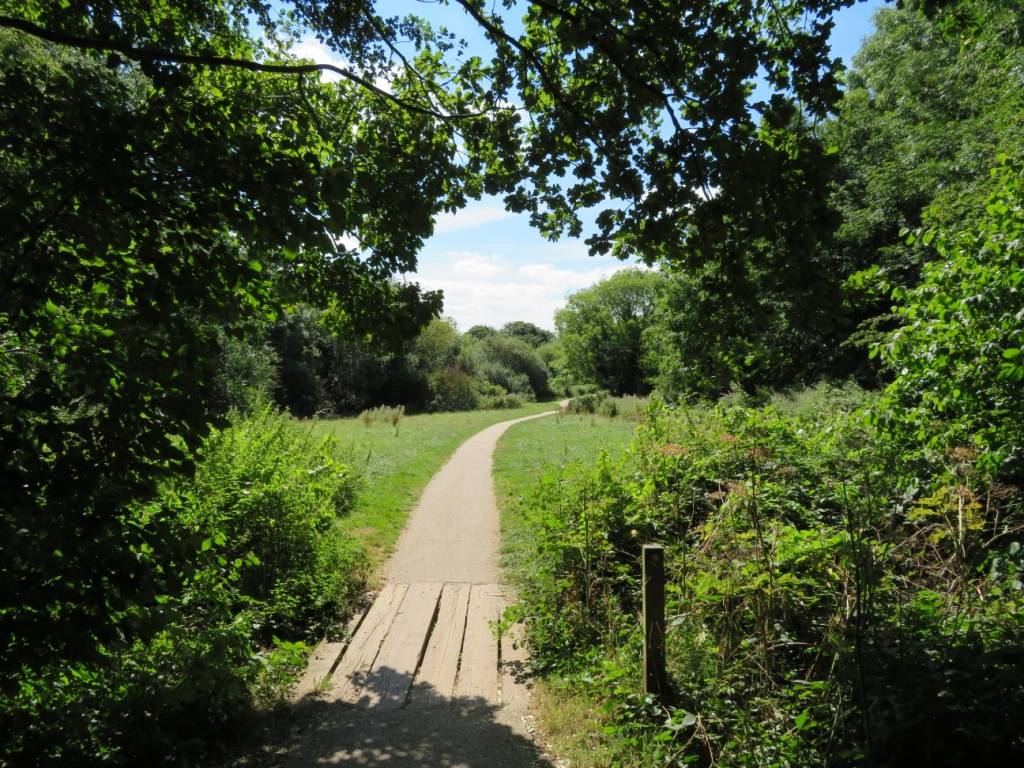
Our route took us initially down the Alexandra Park slope, with great views back up to the (not quite beautiful) Palace on the Hill, passing the Hornsey Reservoir and Treatment Works on our left. The treatment works were built in 1850, following alterations to the New River’s course – eradicating what had been known as the Hornsey Loop – and the introduction of laws requiring London water companies to filter their output.
New River Village, which comes into view as we start walking south along the bank of the New River, is a high-density private housing estate, comprising 622 studios and apartments in nine blocks, built on the 15-acre site of the former waterworks and completed in 2010. Streets are named after springs near the river’s source, notably Chadwell and Great Amwell Lane.
The refurbished Pump House (1905), a typically impressive Victorian utility edifice, struggled as a gallery and studio complex and was subsequently sold to Jehovah’s Witnesses for conversion to a Kingdom Hall, which is still its use today.
After a short stretch of road walking, we re-joined the river just short of Hornsey Station, and this stretch feels very much like being by a canal side passing along a small provincial town. This doesn’t feel anything like the centre of London, it’s an amazing feeling.
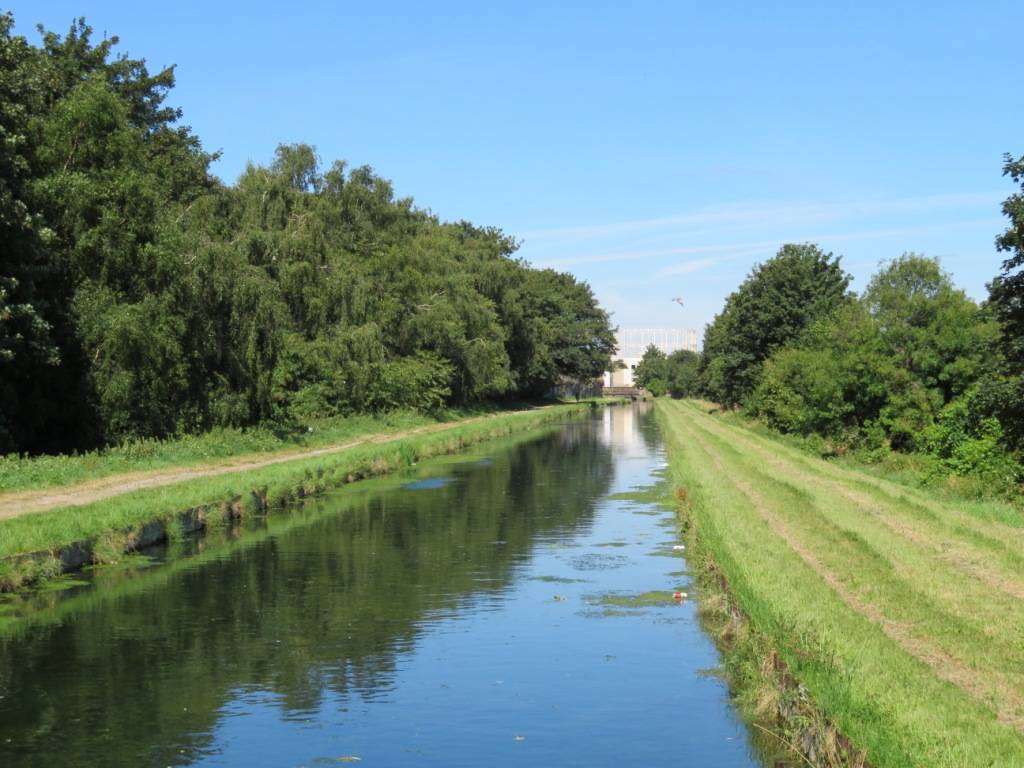
Now it’s time to step down ‘The Ladder’, between Wightman Road and Finsbury Park, where the New River is crossed by a series of side roads. Looking at it on a map, each street is a ‘rung’ on the Ladder between Finsbury Park and Turnpike Lane. This attractive section of the river has been bypassed by the Council; you will have to ask them why – once it appears above ground again round about Warham Rd, it has a bank side that looks perfectly walkable along.
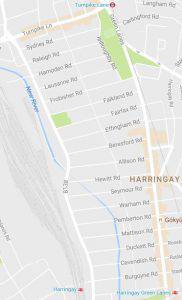
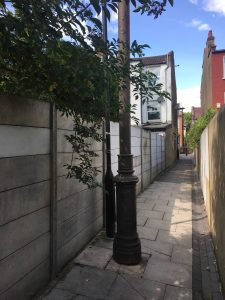
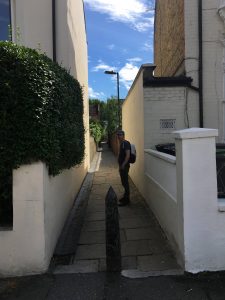
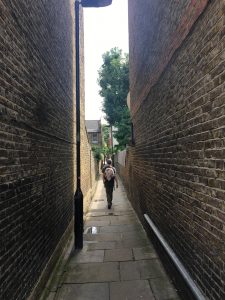 Anyway, not to worry, there is a rather interesting alternative, The Harringay Passage, which runs south through the middle of this estate (you can just see it on the map above). Now you are probably expecting some gloriously romantic explanation as to why this passage came about – a drovers’ route perhaps, for taking livestock to Smithfield Market; or a smugglers’ route for sneaking contraband into the heart of the capital. But sadly the truth is more prosaic – there was an existing sewer there, which was deemed inadvisable to build on top of!!
Anyway, not to worry, there is a rather interesting alternative, The Harringay Passage, which runs south through the middle of this estate (you can just see it on the map above). Now you are probably expecting some gloriously romantic explanation as to why this passage came about – a drovers’ route perhaps, for taking livestock to Smithfield Market; or a smugglers’ route for sneaking contraband into the heart of the capital. But sadly the truth is more prosaic – there was an existing sewer there, which was deemed inadvisable to build on top of!!
Anyway, we are the lucky beneficiaries of that; and it’s worth looking out for the bollards with the date of construction, 1886, and cast iron sewer vents looking like lamp posts with the top knocked off along the route.
Every 100 yards or so the passage is interrupted by one of the streets that form the struts of the ladder – Pemberton, Mattison, Duckett, Cavendish, Burgoyne and Umfreville Street – a mixed bag of references to local land-owners, military and naval figures and dignitaries of the Hornsey district.
And to demonstrate that almost all spaces have friends these days so does this passage – ‘The Friends of Harringay Passage’, a group set up in 2013 by local residents. They write on their website: “After years of neglect and regularly being used for fly tipping, dog toilet, muggings, and other unsavoury activities, in 2013 we formed a Friends group to clean up the Passage.
“Our aim is to create a well-maintained and safe Harringay Passage for local people to use and enjoy … to traffic calm and pocket park the passage junctions combined with a strategy of planting, lighting and public art to unify the passage from start to finish.”
These type of groups are so vital to the well-being of public spaces, using up some of their hard-earnt leisure time after work to get down to regular friends’ meetings and to keep pushing forward…
We left the passage at Cavendish Rd (optional) and headed right to check out a well-known modern British church at the intersection with Wightman Rd. St Paul the Apostle Church was ranked eighth in the ‘Best Modern Church Architecture’ competition. In 1984 the nineteenth-century church building was destroyed by fire. The present building was opened in 1993, designed by London architects Peter Inskipp and Peter Jenkins. It received the ultimate accolade of being included in Simon Jenkins’ book, ‘England’s Thousand Best Churches’, in which he comments: “With its simple rectangular body and pitched roof, it makes a distant allusion to a Greek temple.” As soon as I saw it I liked it, and wanted to go inside – what do you think?
Inside, there is much to enjoy. British artist Stephen Cox, RA created the reredos, titled ‘Christ the Saviour of the World’. There is other modern sculpture, woodwork and design in the church, all very much in keeping with the style of the building. An absolute delight.
We seem to be moving very slowly down the rungs of the ladder, but I implore you to make one more sideways step (again optional), this time to The Railway Fields Nature Reserve (0.8 hectares, 2 acres), which you access via Green Lanes. It started out as a British Rail goods depot, which was closed in 1967 and left unoccupied until the local council bought it in 1975. After a period of being used for a community centre, in 1986, the site started its transition to becoming a haven for local wildlife and an educational centre. In 1990 it secured status as a Local Nature Reserve (LNR), one of the smallest in London. Nothing beats the feeling of walking through the gates, from the busy main road, and suddenly leaving all of that noise behind.
Railway Fields Nature Reserve may be small, but what it lacks in size it makes up for in diversity and the site is renowned for its flora. Among the habitats found here are woodland, scrub, meadow, pond and marshland. Over 200 species of wild flowers have been recorded, 21 kinds of butterfly and more than 60 species of birds.
As we passed through the site, we crossed the old rails and spotted a set of original railway buffers, now overhung with ivy. Half way along on the right, we spotted a high brick tower, which we learnt had been the surge tower at the end of the Harringay Passage sewer, designed to help prevent the sewer overflowing.
A helpful leaflet about Railway Fields can be found at http://www.haringey.gov.uk/sites/haringeygovuk/files/railway_fields_leaflet.pdf. Note it is usually only open on Monday to Friday, 9am-5pm, and the last Saturday of each month. Check opening times at Friends of Railway Fields.
Finally, after our rather zig-zag descent, we reached the bottom rung of the ladder and stepped off into Finsbury Park, following the line of the New River, which has appeared again and will be with us for some time now, along one of the most fabulous stretches of the route.
Green Lanes, which we crossed after Finsbury Park, was part of an ancient route that led from London’s Shoreditch through Enfield to Hertford (a not dissimilar route to the New River) and may have been in use from the second century AD. Now, this really was a famous drovers’ road, bringing animals to London’s Smithfield Market for slaughter, and apparently particularly favoured because it was less busy than other highways. In the twentieth century, it has become famous for being home both to Turkish and Greek Cypriots, who live here in harmony.
The next stage of the walk along the river is fabulous and fascinating, as it clings to the edge of the 100ft contour as the land drops away to reveal the Lea Valley beyond. Directly to the north is a superb view back to Alexandra Palace.
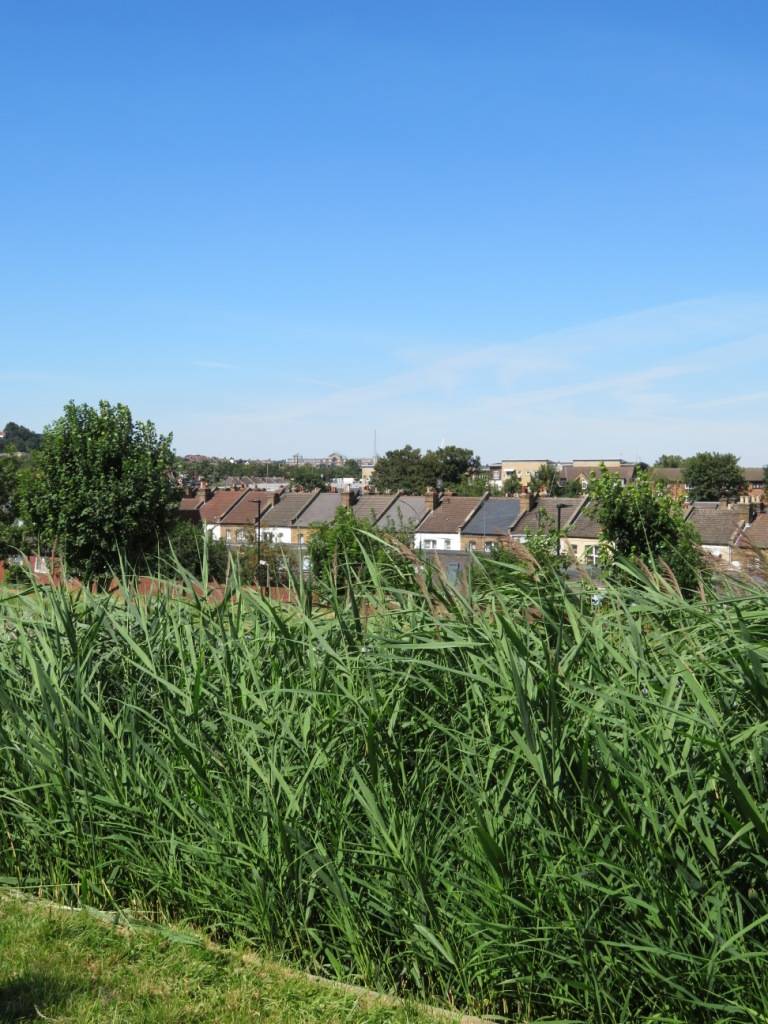
And then there’s a sudden sharp bend in the river from east to south-west because we really are following a contour here. Inside this 400-year-old bend is Woodberry Down, originally dairy pasture, later compulsorily purchased by the London County Council in the 1930s to create an ‘estate of the future’.
The East and West Stoke Newington Reservoirs, fed by the New River, were constructed in the 1830s to meet rising demands for water. In 1946 the water supply to New River Head was truncated here, with the New River ending at the East Reservoir, where it is stored and then piped to Walthamstow for treatment. From here on the river is ornamental.
The east reservoir re-opened as Woodberry Wetlands Nature Reserve (17 hectares, 42 acres) in the spring of 2016, having been sealed off to the public since it opened in the early 19th century. With its reed-fringed ponds and dykes, it’s now a haven for nature.
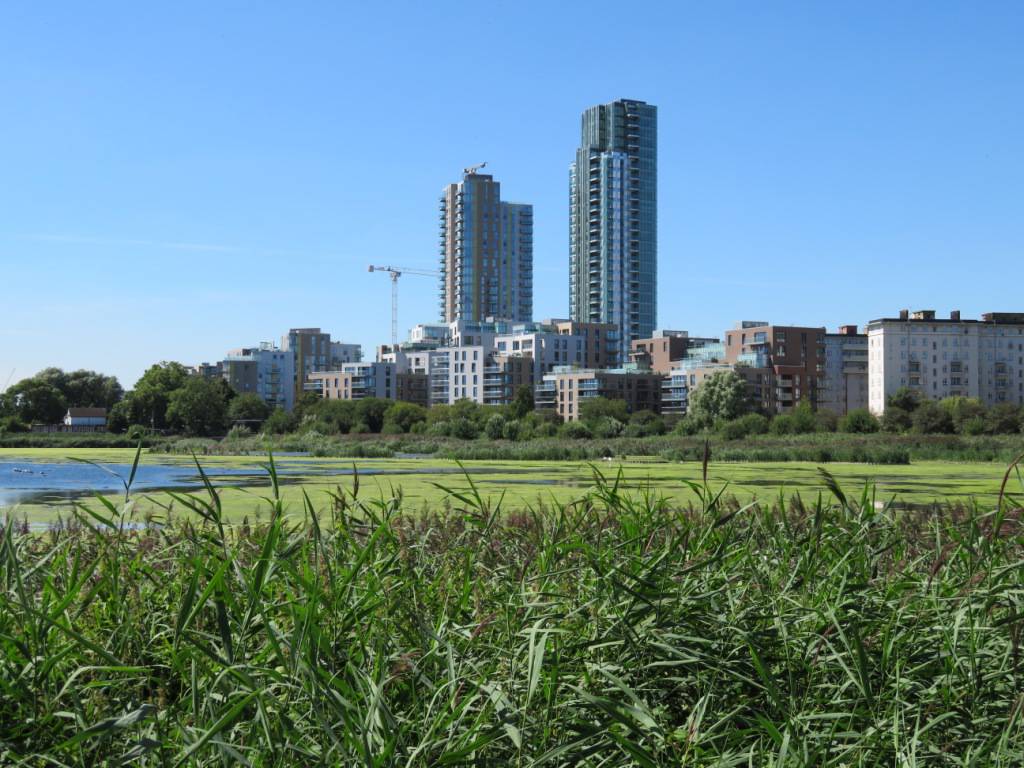
On the far bank is The Coal House, built in 1833. It was previously used as a coal store for a nearby boiler house and as a kitchen to serve the New River Company directors’ dining hall. It has recently undergone significant renovation and is now a kitchen once again called Lizzy’s at The Coal House; and we paused here on what by now had become a very hot day for an agreeable cool drink, looking out across the water at the herons perched on the dead boughs in the middle.
The contrast between the surrounding tower blocks and the wild wetland habitat with old oak trees is almost unbelievable. These tower blocks form Woodberry Down, one of the largest housing estate redevelopments in Britain. Woodberry Down was originally the brainchild of Peter Mandelson’s grandfather, Labour MP Herbert Morrison, who wanted to rehouse working-class Londoners living in inner-city squalor in the 1930s.
More recently it has been the subject of a controversial regeneration, which has seen a mix of social and private housing built in place of the 2,000 council homes. It certainly has been issued with the mandatory ‘iconic silver ball and flowing water feature to denote modernity:
Whilst the East Reservoir is reserved for nature, the West Reservoir is all about human endeavour – here you can try out sailing, canoeing, kayaking or open water swimming.
The architectural oddity at the west end of the reservoir is the Castle Pumping Station – a Victorian water pumping station built in the Scottish Baronial manner, possibly based on Stirling Castle. Although it ceased to operate in 1942 – and after a big struggle to prevent its demolition, it was converted into an indoor climbing centre in 1995 by architect Nicholas Grimshaw (of Eden Project fame) – its turrets and battlements remain thrusting into the sky, a testament to the Victorian zeal for industry and development and a love of all things flamboyant. And although its striking towers and turrets appear purely decorative, they were each designed with a specific practical function – one housing a chimney shaft, another a water tank – while the turret with the conical roof contains a spiral staircase leading to the roof. The three front buttresses are home to a section of the tower’s flywheels.
The New River engineers had a bit of a challenge as they entered Clissold Park (23 hectares, 56 acres), because the Hackney Brook crossed west-east at this point, providing a natural barrier. Their solution was to build an embankment called the Highbury Bank; and the New River’s water was carried in a wooden channel along the embankment, which became known as the boarded river. In the 1860s the embankment was abandoned when new pipes on an alternative course were laid.
The two ponds that we come to first used to take their water from the Hackney Brook, not the new river as you might have guessed. The brook, now underground, flows on east and then along the northern boundary of Abney Park Cemetery.
Clissold House was built, in the latter half of the 18th century for Jonathan Hoare, a City merchant, Quaker, philanthropist and anti-slavery campaigner. The park was created to be its pastoral idyll. After 1811, the estate passed to Augustus Clissold; but, when he died in 1882, developers closed in. But activists John Runtz and Joseph Beck (members of the Metropolitan Board of Works) convinced the authorities to open it as a public space in 1889. A fountain was erected in 1890 commemorating them; later, the park’s two ponds were named after them too. A recent National Lottery Grant has restored the house and park to their former glory.
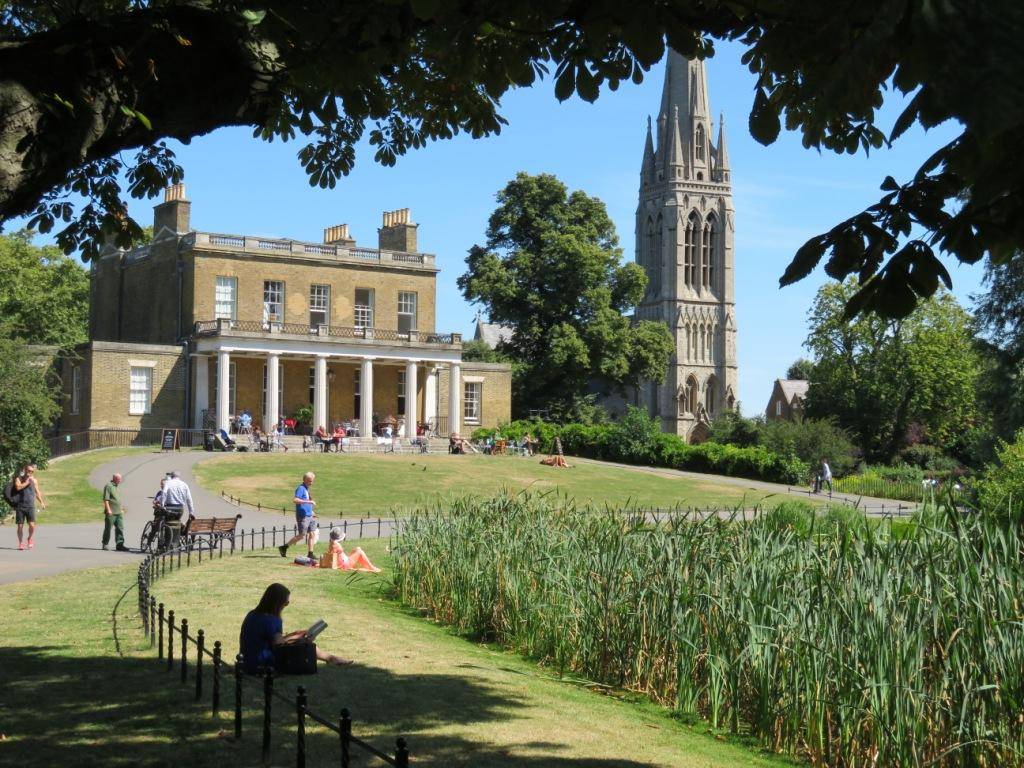
There’s another remnant of the New River to be found in front of Clissold House The hard to fathom twists of the New River at this point seem more logical when you realise that it was routed to follow the contour of the land as closely as possible. It’s this sort of observation that makes you remember that only a 150 years or so ago this was rolling downland in the midst of the countryside, just like anywhere else you might see on your regular rural rambles. Houses and cities tend to obscure gentle contours; it takes a steep hill before we really notice the lie of the land. Cycling in cities I’ve noticed is a great way to get to get to know contours as you notice any ascent, however gradual, in terms of extra effort.
In the early 1800s, London’s rapid population growth proved too much for inner city burial grounds, which were literally overflowing. Parliament passed a bill in 1832 to encourage the establishment of new private cemeteries. Within ten years, seven had been established (later dubbed ‘The Magnificent Seven’ by architectural historian Hugh Meller), one of which was Abney Park.
The site of Abney Park was formed from the estates of Fleetwood House and Abney House, the latter of which had been the home of renowned non-conformist and hymn writer Isaac Watts. This association quickly made Abney the foremost burial ground for Dissenters – those practising their religion outside the established church. It was founded on these principles, with a non-denominational chapel at its core, and was open to all, regardless of religious conviction.
Uniquely in London, Abney was also originally laid out as an arboretum, with 2,500 varieties of plants. An alphabetical planting of tree species was set out around the perimeter along with collections of oaks, thorns, pine and others within.
In the 1970s after the cemetery company went into administration, Abney fell into disrepair and was abandoned, allowing a uniquely wild atmosphere to develop at the site. The London Borough of Hackney took over ownership of the site in the 80s and started to manage it in partnership with the Abney Park Trust as lessee.
It was decided to maintain and manage this new and unique urban wilderness and today management aims to balance the needs of Abney’s wildlife with the requirements of the historic landscape and structures as well as the Park’s memorial role.
What can I say other than, if cemeteries are your thing, this is a must! It is hard to imagine that such a spot could be found in the middle of a city. As one Trip Advisor writer commented: “It’s certainly not your typical London cemetery: it’s a natural park in the middle of the city.” Famous tombs include those of General William Booth, founder of the Salvation Army; and Dr Isaac Watts.
Walking back west again, Stoke Newington Church St still has many of the characteristics of a typical high street in a small town, which once upon a time of course it was; until enveloped by the ‘big bang’ of London growth in the 19th century. It was also a favourite spot of my favourite author and writer, Daniel Defoe, who lived for a while at No. 95 (blue plaque). There is also a marble bust of him in Stoke Newington Public Library across the road, a classic late Victorian building.
And if 20th-century architecture is more your thing, you will be attracted by the Stoke Newington Town Hall, built in 1935-37 by the architect J. Reginald Truelove. Designed in an English Renaissance style, the buildings were fitted out in art deco. The building is a lasting reminder of Stoke Newington’s great civic pride in its status as a Metropolitan borough.
Finally, there are two churches on the street, both rather confusingly known as St Mary’s. The first (smaller church) was built in 1563 and was partially rebuilt in the 19th century and then again in the 1950s after heavy bomb damage during World War II. The second church, built in 1858 and designed by Sir George Gilbert Scott, is St Mary’s New Church, with its 250-foot steeple still a notable Stoke Newington landmark.
We then cut back through the park, in front of Clissold House and the remaining fragment of the New River, to exit in the south-west corner of the park, called the Robinson Crusoe exit (close to a deserted traffic island?!)
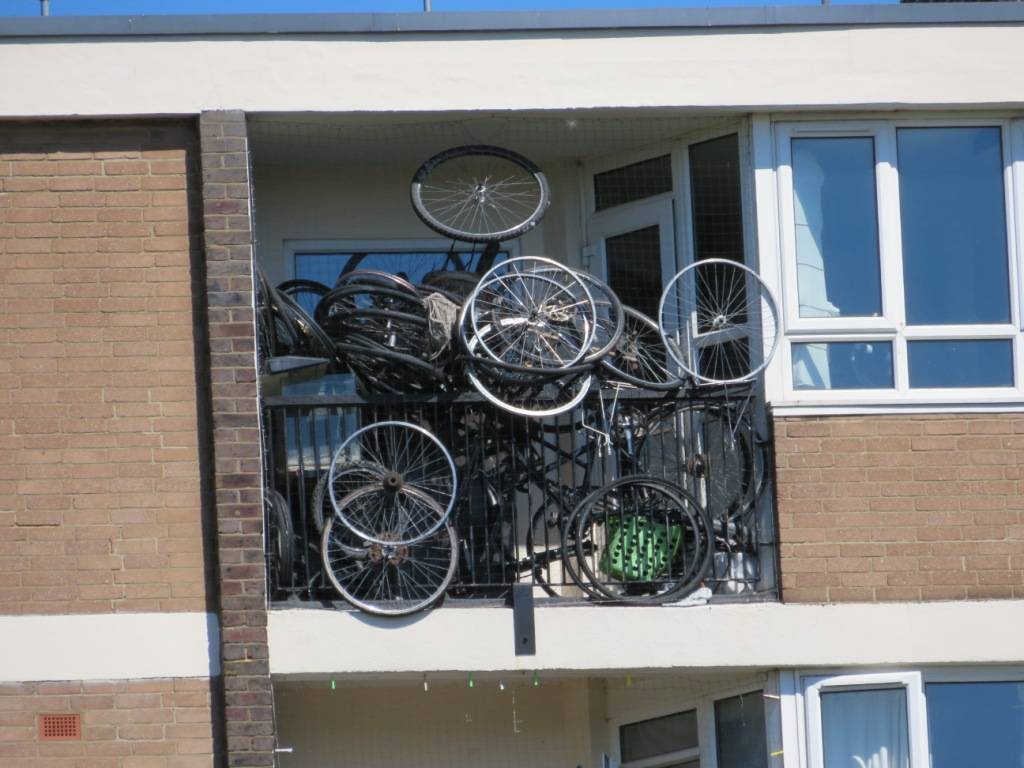
Please suggest a witty caption…
Another double-back led us past the New River Café. Just down from here, we took a right down the exquisite Aden Terrace, which is the exact route the New River took before it became redundant. The allotments were created in 1953 above the filled-in river.
Today the allotments are administered by the Hackney Allotment Society, and a plot costs a very modest £21 per annum to rent. There must be a catch I hear you see…and there is! The waiting list is ‘temporarily suspended’ due to the excess of demand over supply. Not so temporary it would seem. The minutes of the society read: “In June 2008, with the waiting list about to hit 300, the Committee decided to take the unprecedented step of temporarily closing the list. This decision was reviewed in October 2009 and upheld again at the AGMs in October 2010, 2011, 2012, November 2013 and October 2014 & 2015.” Not surprisingly the folk we saw hard at work on the allotments that day looked very committed.
Petherton Road (or ‘Pethy’ Road as the locals apparently like to call it) had a slightly different, but equally elegant solution to what to do with a redundant narrow linear space – they turned it into a linear green, now with mature trees, that on this hot day provided welcome shade as we headed south. Apparently, it was once used for parking; the Local Residents’ Association should be proud of itself for gaining priority for the walker over the car.
The road continues, still wider than normal, past the Snooty Fox pub and Canonbury station. And then comes a rather splendid re-working of the original channel, New River Walk, now a landscaped half-mile of which Islington Council are rightly proud. A thin strip of green curves round from St Paul’s Road to the Essex Road, overshadowed by trees, with what looks like the New River wiggling down the centre. But there are a few clues that it’s not. For a start the water’s not flowing, it’s still, hence ideal for leafy reflection. More obviously the channel’s not straight, it bends and curves in an attractive manner, whereas Myddelton’s original channel cut direct. Its transformation took place in the 1950s, creating a replica of a moorland stream with shrubs and rockeries of Westmoreland stone.
We pass a small round hut that looks almost like a mini-igloo; in the 18th century, it was used by a watchman whose job was to prevent bathing and fishing in the drinking water.
But that’s it for water on the surface. The final section along Astey’s Row is entirely dry, home to a linear rock garden that (presumably) has seen better days (and that’s Greenpeace HQ in the old boiler house alongside).
Essex Road is where civilisation kicks in again; we felt a little shell shocked. We decided to doff our caps (baseball caps worn in reverse against the sun of the day) to the New River’s founder, so continued on down to the south side of Islington Green, where the Upper Rd splits, to peer up at the statue of Sir Hugh Myddelton, in Elizabethan costume with, very appropriately, two drinking fountains beneath. It had been unveiled by William Gladstone, then Chancellor of the Exchequer, in 1862.
The Duncan Terrace Garden was laid out in 1893 after the River had been put into pipes in 1861. Look upwards in the lower part of the garden to enjoy a cluster of 300 bird and bee boxes hugging the trunk of a tree, entitled ‘Spontaneous City in the Tree of Heaven’, part of the Secret Garden Project.
Crossing City Road, we followed the route along Owen’s St (via Owen’s Field in fact to maximise green spaces) and across St John’s St; then a quick diversion to look at Myddelton Square. The square and St Mark’s Church (1827) were designed by William Chadwell Mylne, surveyor to the New River Company from 1811 (his father, who had filled the post before him, named his son after the Chadwell stream that fed the New River. What a fabulous tribute-ary!!). The church was gutted and the north side of the square destroyed in the 1940s, as a result of World War Two bombing, and rebuilt in replica by the New River Company. The dramatist and actor Thomas John Dibdin, who wrote for the nearby Sadler’s Wells stage, was one of the first residents, moving into no. 7 in 1826.
T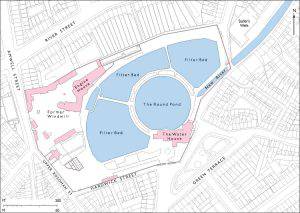 he New River Head site is of national historic importance having been in continuous use for the provision of public water supply since the opening of the New River. The end point of the river was a small reservoir called the ‘Round Pond’. The site is best seen from the Nautilus House Garden and visitor information point, accessible to the public from 8am to 4pm (7pm Summer), just down from Myddelton Square via the east end of Myddelton Passage (although not open the day we went, frustrating).
he New River Head site is of national historic importance having been in continuous use for the provision of public water supply since the opening of the New River. The end point of the river was a small reservoir called the ‘Round Pond’. The site is best seen from the Nautilus House Garden and visitor information point, accessible to the public from 8am to 4pm (7pm Summer), just down from Myddelton Square via the east end of Myddelton Passage (although not open the day we went, frustrating).
These are some of the things to look out for:
1) The Engine/Pump House and South Stores was built circa 1768, with later additions. It originally accommodated steam engine pumps, and part of the ground floor of this building remains in continued use by Thames Water, housing an operational pumping plant.
2) The Windmill Base is the round base of the former windmill, first built circa 1708. The windmill pumped water to the Upper Pond (now known as Claremont Square Reservoir), prior to the arrival of steam power.
3) The Inner Pond: the remaining revetment is the only fragment of the original ‘Round Pond’; it can just be seen on the north side of the New River Head building.
4) New River Head Building, built in 1919; until 1993, it was Thames Water offices and still incorporates the relocated New River Company’s 1693 Oak Room, Grade 2*. Now luxury apartments (Rosebery Avenue)
5) The Laboratory Building: listed Grade 2, constructed in 1938, was used for testing water quality. Love this art deco style curved building. Now apartments (Arlington Way)
Finally, we reach Sadler’s Wells. And it turns out that plentiful water from the New River was a very important stage prop at one stage in its history. At the start of the 19th century, the theatre installed a huge water tank that covered the entire stage, with water pumped in from the New River by an Archimedes wheel. The water would become dirty not only from the shows, but the actors would bathe in the tank, along with rowdy audience members jumping in to see if the water was real.
The first show put on was The Siege of Gibraltar. It opened in 1804, and it was a play that depicted the naval battle between the English Navy and the Spanish Armada. There were 177 scale ships on the liquid stage, all equipped with live guns and ready for battle. The water tanks were eventually removed in 1824 when the craze for Aqua drama had run its course, as these things do!
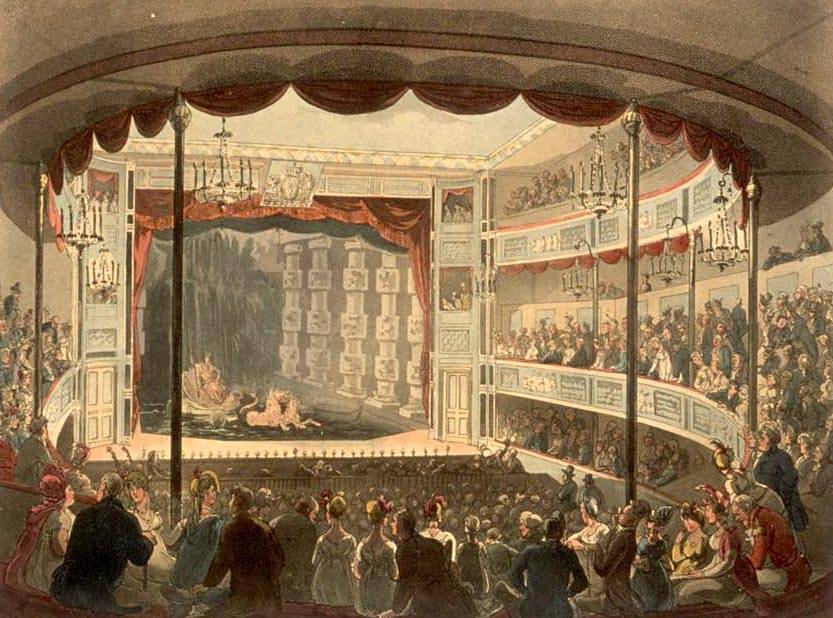
The ‘aqua drama’ Pericles at Sadler’s Wells c. 1808
Finally, time to relax?! Well, why not let’s finish at an old spa then, Spa Green Garden. Established in 1737, it became a popular spa, and the spring flowed until the 1860s.
So we start to reflect on the day’s walk, but then look up and realise we are staring straight at one of the most important pieces of 20th century modernist architecture, the Spa Green Estate; billed as the most complete post-war realisation of a 1930s radical plan for social regeneration through Modernist architecture; designed by architect Berthold Lubetkin in the 1930s and completed in 1946.
The Spa Green Estate has been eulogised by architects and historians before and after its Grade II* listing in 1998. ‘Rightly listed’, John Allan remarks, ‘the first and best of Lubetkin’s post-war housing schemes set a standard in architectural and technical accomplishment unmatched by any contemporary. Over half a century later Spa Green still radiates a sense of optimism that defies the commonplace dismissal of flatted estates as a modern urban aberration.’ Lubetkin’s declaration ‘Nothing is too good for ordinary people’ is still the motto of the Estate. Sit on the bench, relax and you, the everyday urban rambler, can be the judge of just how good you think it is!
THE ROUTE
- From the east end of South Terrace, take the footpath heading downhill due S, which then runs down S with Hornsey Reservoir on the left and a cricket ground on the right
- Leave by the southern exit, onto Newland Rd swing left, then first left into Greenways (a footpath, two bollards at the start), which heads NE, crossing the New River
- Immediately after you have crossed the river, take a right through a gate and the path follows the river, which is immediately on the right
- When you reach the main road (Turnpike Lane), cross, then turn left under the railway bridge
- At the traffic lights turn right up Denmark Rd (blocked to cars at this point), then at the top turn left and turn right where you join Wightman Rd
- Take the next right into Hampden Rd (you will see Hornsey station at the top), cross the New River and immediately join it on the bank heading south; further down, the path crosses the river again and emerges once again in Wightman Rd, where you turn right
- Head S down Wightman Rd, then take the third L into Warham Rd; you will pass over the New River once again, and a few moments later reach a narrowing of the road, where you turn right into Harringay Passage, which you follow S until it reaches Cavendish Rd (the fourth street you come to), where you turn right
- On reaching Wightman Rd, turn left and follow it to Umfreville Rd, then turn left and walk down to the end to the busy Green Lanes
- Turn right onto Green Lanes and you will shortly see the entrance to Railway Field Nature Reserve on your right; once you have visited, continue under the railway bridge, take the first right into Lothair Rd North, then the 3rd left into Tancred Rd
- At the end, turn right into Endymion Rd, then cross by the pedestrian crossing at the New River, and enter the New River gate into the park. Follow the New River, first on the E side, then crossing a bridge and following it on the S side until it reaches the Green Lanes
- Cross here, and then follow the river again (joining the Capital Ring) as it heads due E, with great views N back to Alexandra Palace; the path then swings round in a horseshoe shape to head S until you reach Newnton Close; head left over the bridge, then right into Woodbury Wetlands Nature Reserve
- Follow the path right (S) around the reservoir, swinging round past the excellent café; then back along a floating walkway to return to the N side; cross Lordship Rd, then continue SW along the N side of the West Reservoir, past the water sports centre to reach the Castle Climbing Centre, back into Green Lanes, where you turn left (still following the Capital Ring)
- Turn left into Clissold Park and follow the two lakes along their south side; then turning S, keeping to the side of the park and exit into Lordship Terrace, with the back of Stoke Newington Town Hall on your immediate right
- Turn R into Lordship Rd, taking the left fork to join the main Stoke Newington Church St; turn left until you reach the entrance to Abney Park Cemetery
- Turn left through the wrought iron gates into the cemetery and take a circular route of your choice, making sure you don’t miss the chapel in the middle (you leave the Capital Ring at this point). Return out of the same gate and head back W down Stoke Newington Church St, passing the front of the Public Library and the Stoke Newington Town Hall on your right
- Continue past The Old Church on your R, then turn R back into Clissold Park just across from St Mary’s Church. Once in the park, take the first left, then right tracking the E and north side of the New River ‘remnant’; follow it to the end, then head S to the southernmost exit to the park (Robinson Crusoe exit)
- Turn left immediately into Stoke Newington Church St; take the second right at the New River Café down Clissold Crescent, and then almost immediately bearing right down the amazing New River Path along Aden Terrace, alongside allotments above the course of the river
- At the end of the New River Path cross the Green Lanes road again into Petherton Rd; walk S down the green space in the middle, again the course of the New River
- Continue across the roundabout at the end of the green, pass Canonbury Station on your right, becoming Wallace Rd; when you reach St Paul’s Rd, turn left then immediately right across a pedestrian crossing back into the dedicated New River Path
- At the tiny Willow Bridge Rd, take a left and then immediately right back into the dedicated path as it goes along Canonbury Grove
- You come out at the end of Canonbury Grove onto the Canonbury Road; cross this and go through the playground and then through Astey’s Row Rock Garden
- Eventually, you come to the end of the path, at which point turn left on to the Essex Rd, where you turn R (S)
- … until you reach Colebrooke Row, where you turn left and then swing R (S)
- This comes into the linear garden which is above the New River, which is culverted at this stage; and it takes you all the way through greenery to the major City Rd, which you cross over into Owen St
- At the end of Owen St, turn left into St John St, then right into Chadwell St and follow it into Myddelton Sq; go through the gardens, swing to the left and exit at the SW corner into Myddelton Passage
- At the end of Myddelton Passage, turn right into Arlington Way and you will shortly reach Rosebery Avenue and Spa Green Garden, the end of the walk.
PIT STOPS
Lizzy’s @The Coal House, West Bank, Woodberry Wetlands (07752 147073, www.lizzysatthecoalhouse.com)
Clissold Park Café, Clissold Park House. Lovely to sit out front when the weather is good. Big outcry when it transformed a few years back from a cheap-and-cheerful egg-and-chips joint to a gastro experience under the wing of the upmarket Company of Cooks. Open every day.
QUIRKY SHOPPING
Stoke Newington Church St; Camden Passage, Islington
PLACES TO VISIT
Abney Park Cemetery (020 7275 7557, www.abneypark.org) Open every day 8am to hour before sunset – check for exact times
MORE TO DISCOVER
Learn to climb: at the Castle Climbing Centre
Start sailing: West Reservoir Centre
Read: ‘The Magnificent Seven’, London’s First landscaped cemeteries, by John Turpin & Derrick Knight
Walk: the entire length of the New River from its source in Hertfordshire

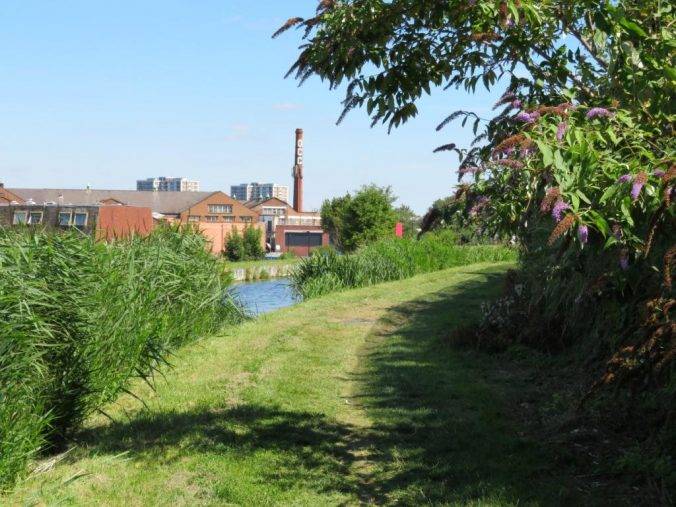
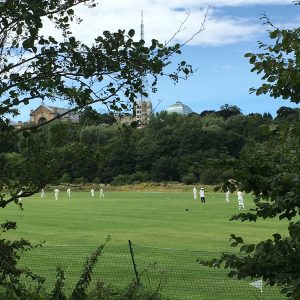
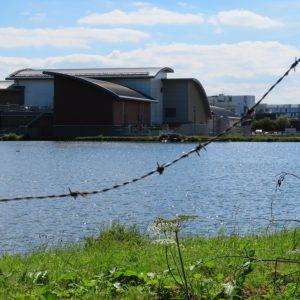
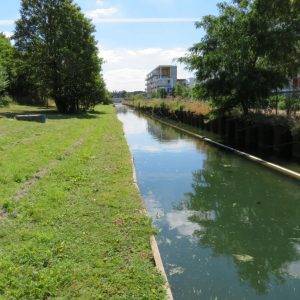
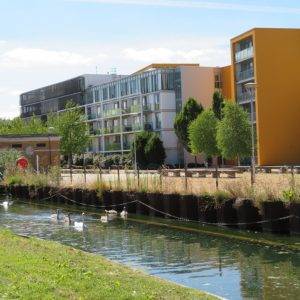
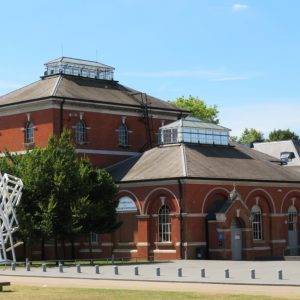
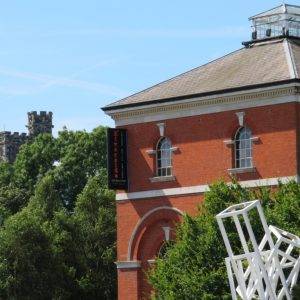
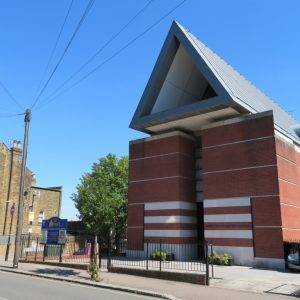
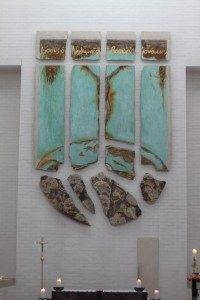
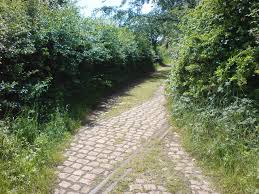
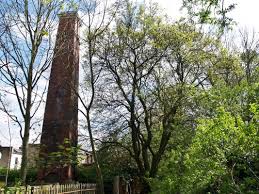
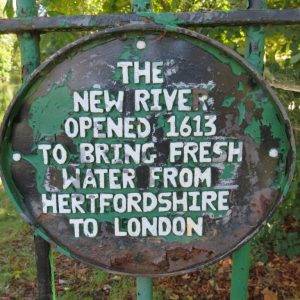
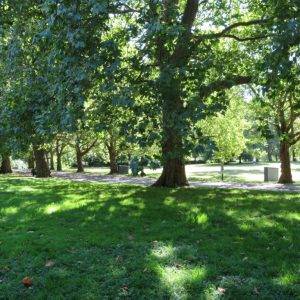
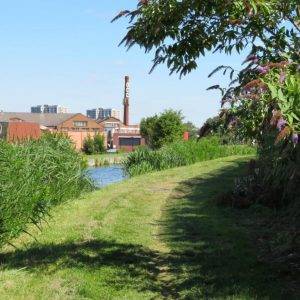
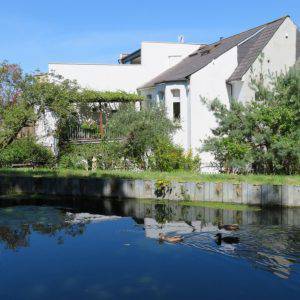
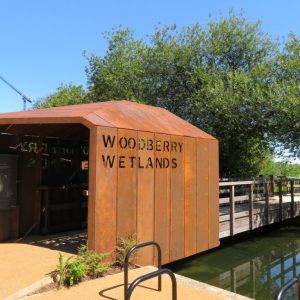
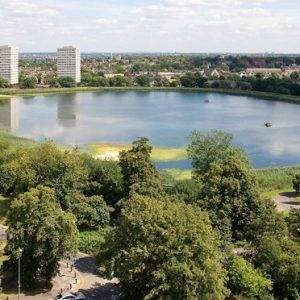
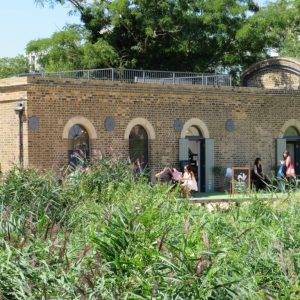
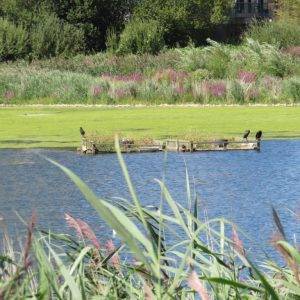
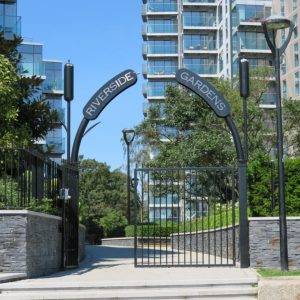
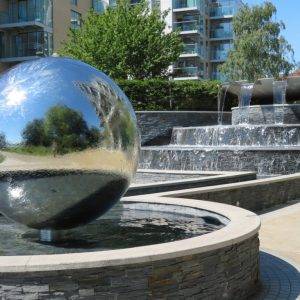
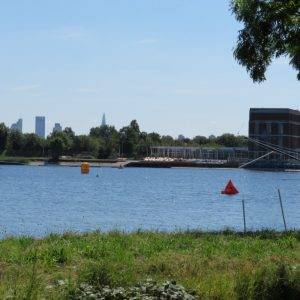
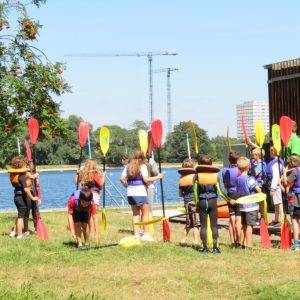
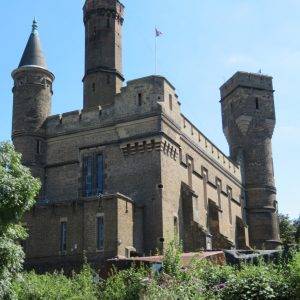
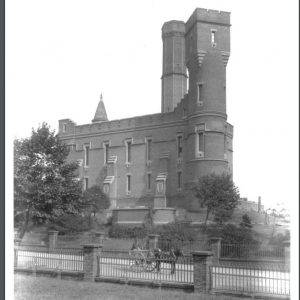
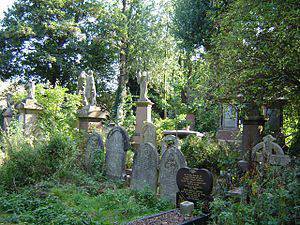
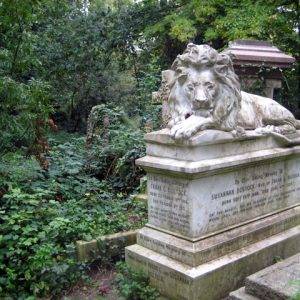
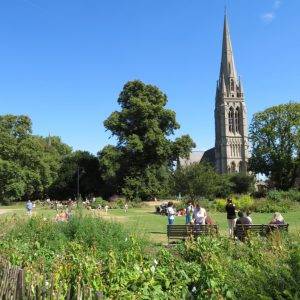
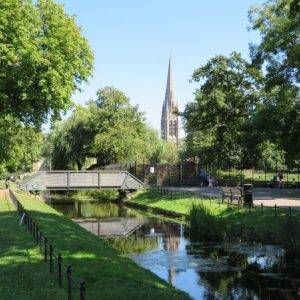
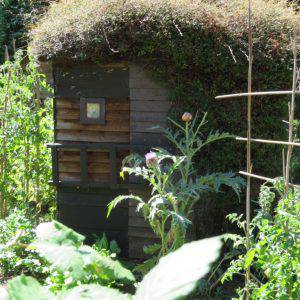
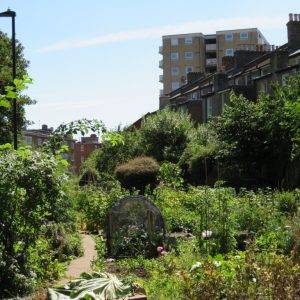
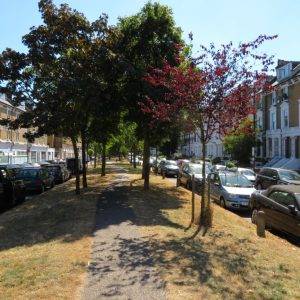
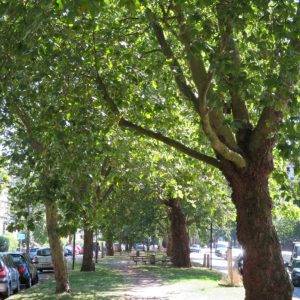
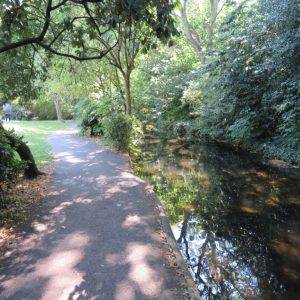
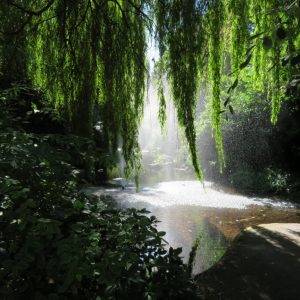
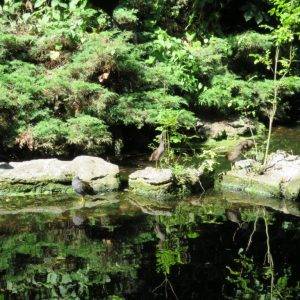
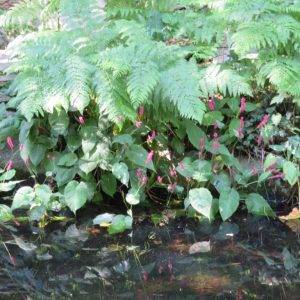
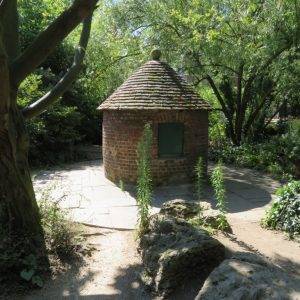
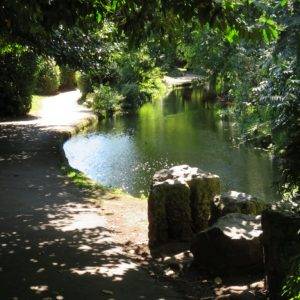
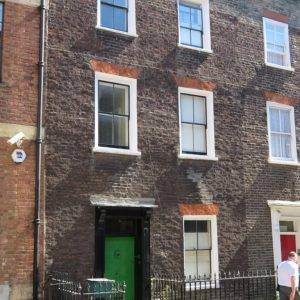
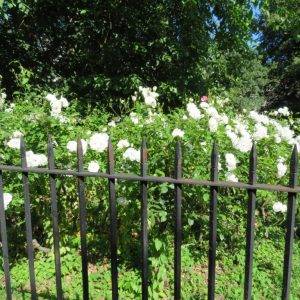
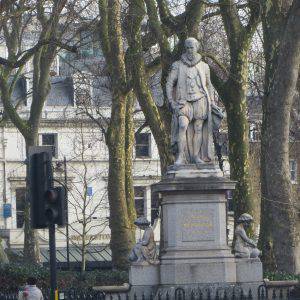
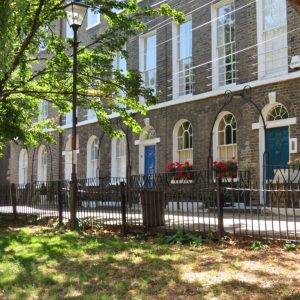
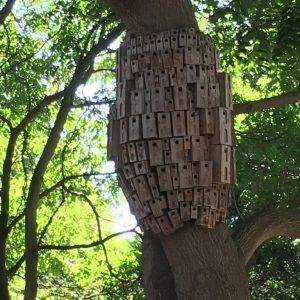
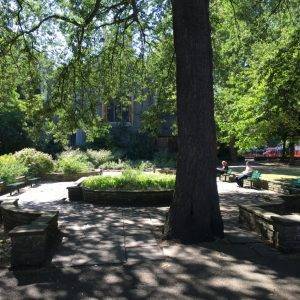
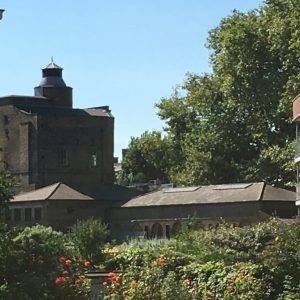
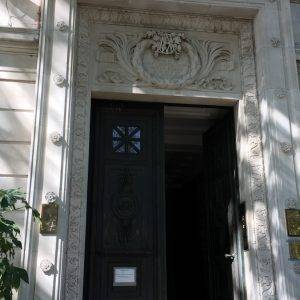
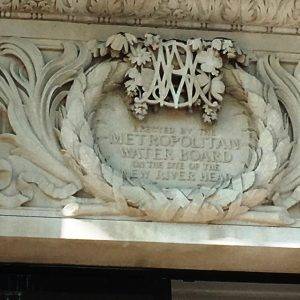
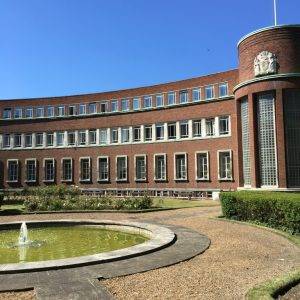
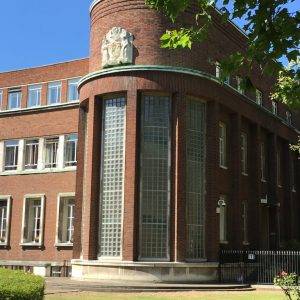
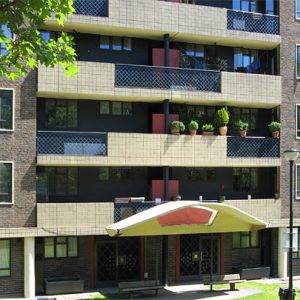
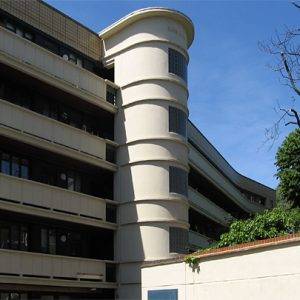


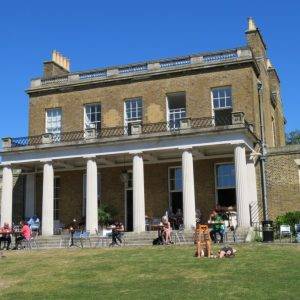
0 Comments
2 Pingbacks